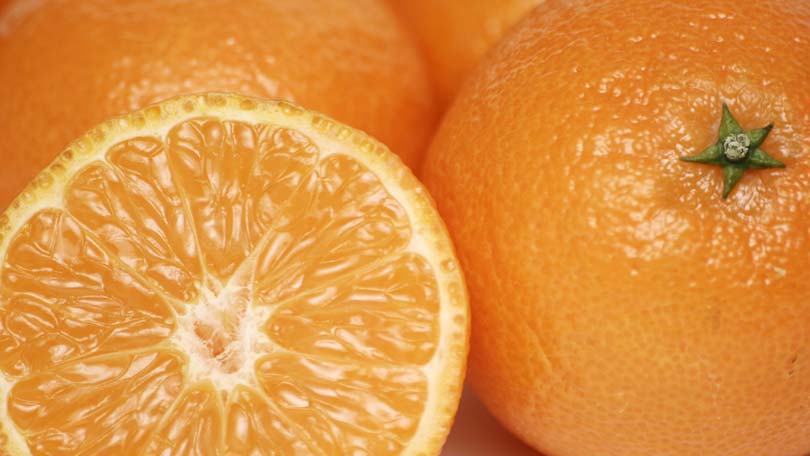Oranges are one of the most commonly enjoyed citrus fruits, whether as a delicious treat eaten out of hand, as a healthful beverage when juiced, or as a prized ingredient in many recipes from appetizer through dessert courses.
Originally native to southeast Asia, the orange is referred to as “Chinese apple” in many languages. As with so many of the citrus fruits, the orange traveled with traders across Asia and Europe, and then found their way to the New World on Christopher Columbus’ voyages. North American orange cultivation pioneers include William Wilfskill, who planted the first orange tree in Los Angeles in 1841, and Eliza Tibbets, who started the navel orange industry thirty years later in California. One of her original trees continues to produce fruit today.
Oranges flourish in semitropical and subtropical localities. Top orange producers include Brazil and the United States – specifically, Florida. California also produces a large portion of the world’s orange supply; Florida’s oranges produce a sweeter juice, while California’s oranges tend to be more aesthetically pleasing. Other orange industry leaders include China, India, Mexico, and Spain.
A variety of oranges are enjoyed for their specific properties and characteristics.
Valencia oranges are most common. They do not have many seeds, and they tend to provide an excellent quality and quantity of juice. They are a later-season orange, so they fill the market when the navel oranges are not longer producing. Sometimes the Valencia will “regreen” when chlorophyll returns to the peel during ripening, but this does not impact the quality of the fruit.
Navel oranges are best for eating out of hand. They have no seeds, and their easy-to-peel fruit is better for eating immediately than for juicing. Although there are many varieties of navel oranges, the Washington is perhaps most popular.
Seville oranges are highly valued as the primary ingredient in marmalade. Originally from Spain, Seville oranges are also grown in Florida.
Blood oranges, also called Moro oranges, are prized for their beautiful rich red flesh as well as for their mildly berry-infused flavor. Their intense color comes from anthocyanin, an antioxidant that provides many cancer-fighting and aging health benefits.
Mandarin oranges are smaller than other varieties. Their sweet fruit is a favorite in many recipes, and they also make a delicious treat eaten as is.
When shopping for oranges, whatever their variety, look for an orange that is heavy for its size to indicate a good supply of juice; lighter fruit tends to be drier inside. Skin should be shiny. A navel orange should have a small navel to indicate that it was not too ripe when picked.
You can store oranges in the refrigerator, but they keep best in a cool region of your kitchen. Oranges will taste best if eaten within several days, and their juice should always be drank as soon as possible after juicing to preserve taste and vitamin value.
Oranges are a flavorful component of many food and beverage recipes. This cake will make a lovely addition to any brunch table.
Orange Poppy Seed Bundt Cake
For cake:3 cups all-purpose flour
1 tablespoon baking powder
1/8 teaspoon salt
¼ cup grated orange zest
5 eggs
1 cup canola oil
1 tablespoon vanilla extract
1 cup orange juice
½ cup poppy seeds
For syrup:
¼ cup orange juice
¼ cup sugar
3 tablespoons butter, melted
1 tablespoon Grand Marnier
Preheat the oven to 350 degrees. Prepare Bundt pan by greasing and flouring lightly, or spraying with Pam.
Combine flour, baking powder, salt and orange zest in large bowl; set aside.
In another bowl, combine eggs and sugar. Beat on high until light and fluffy.
Add oil and vanilla, mixing until blended.
Add flour mixture and orange juice, alternating so that about a third is added each time. Mix well without over stirring. (The goal is to combine ingredients, but not overwork the batter.)
Add poppy seeds and stir lightly.
Pour batter into prepared Bundt pan.
Bake for one hour at 350 degrees. Cake should test done when pick is inserted midway between center and edge of pan.
Cool on wire rack for five minutes, then remove from pan to continue cooling.
Combine syrup ingredients in small pan, and heat for five minutes until thickened.
Use skewer to prick small holes all over surface of cake.
Gradually pour syrup on top and sides of cake. If you pour very slowly, the cake will absorb the syrup as you pour.
Cool completely.
Here is another recipe that is perfect for brunch. Serve this flavored butter with bran muffins, cranberry bread, or pancakes. For a special touch, use a melon ball scoop to make butterballs after the mixture has chilled.
Whipped Orange Butter
6 tablespoons butter, softened
zest of one orange
1 tablespoon confectioners’ sugar
¼ teaspoon cinnamon
1 tablespoon fresh orange juice
Put butter and zest in small bowl, mixing until well combined.
Mix in confectioners’ sugar, cinnamon, and orange juice, stirring until smooth.
Cover with plastic wrap and refrigerate for at least one hour, until firm.






